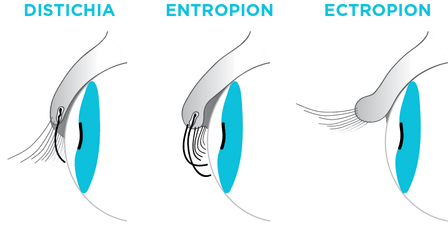Virtual Library | Tearing & Tear-Staining Treatment
Tearing is due to an overflow of tears, which can result in staining under and around the eyes. In addition to visible tears, your pet may show signs of squinting, redness or irritation. Some of the contributing factors are due to eyelid conformation, but tearing can also indicate more serious ocular disease. Read on for details about breeds that are predisposed to this condition and therapy options.
← Flip through our digital brochure
Note: Every case of tearing and tear-staining may have slightly different causes and therefore different ideal treatment plans.
 While this brochure primarily addresses the causes of chronic tearing, it’s important to know that a sudden increase in tearing can indicate a more significant and vision-threatening underlying disease, such as a corneal ulcer, glaucoma or uveitis (inflammation within the eye). If you notice an abrupt change in your pet’s tearing, notify your family veterinarian or a veterinary ophthalmologist immediately.
While this brochure primarily addresses the causes of chronic tearing, it’s important to know that a sudden increase in tearing can indicate a more significant and vision-threatening underlying disease, such as a corneal ulcer, glaucoma or uveitis (inflammation within the eye). If you notice an abrupt change in your pet’s tearing, notify your family veterinarian or a veterinary ophthalmologist immediately.
So, You Brought Home a Bulldog
Cataracts and Cataract Surgery
Entropion Causes and Treatment
Feline Herpesvirus and Treatment
OFA Certification Registry Exams
Visit our blog, In Focus, to learn more about the pets we see, the treatments we offer and the services we provide to help your pet “see a better life.”
 Tearing is due to an overflow of tears, which can result in staining under and around the eyes. In addition to visible tears, your pet may show signs of squinting, redness or irritation.
Tearing is due to an overflow of tears, which can result in staining under and around the eyes. In addition to visible tears, your pet may show signs of squinting, redness or irritation.
 While each case of tearing should be evaluated on an individual basis to determine the specific underlying cause and degree of concern, certain breeds are predisposed to tearing and tear-staining based on the relationship of the eyelids to the ocular surface. Check your pet against the following breeds to learn more:
While each case of tearing should be evaluated on an individual basis to determine the specific underlying cause and degree of concern, certain breeds are predisposed to tearing and tear-staining based on the relationship of the eyelids to the ocular surface. Check your pet against the following breeds to learn more: